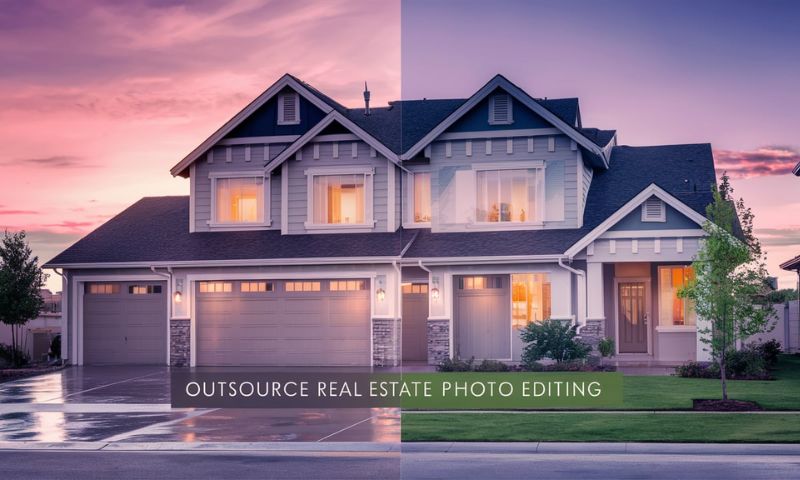High-quality, attractive photographs have become not just an asset but a necessity in real estate marketing. They can make the difference between a quick sale at the asking price and a property languishing on the market for months. Real estate photo editing plays a crucial role in creating these captivating images. It involves enhancing raw photographs to showcase properties in their best light, correcting imperfections, and sometimes even adding virtual staging elements. This process can transform ordinary pictures into stunning visual representations that highlight a property’s best features, amenities, and potential.
Recognizing the importance of high-resolution images, many property marketers, agents, and builders are increasingly opting to outsource their photo editing needs. Want to know why? In this blog post, we’ll explore why real estate photo editing services have become a game-changer in the industry and how they can benefit your business too!
The Pitfalls of In-House Real Estate Photo Editing
While many real estate professionals recognize the importance of high-quality images, handling real estate photo editing in-house often presents significant challenges. These obstacles can hinder the effectiveness of your marketing efforts and potentially impact your ROI. The major challenges include:
- Time constraints: Real estate professionals and in-house editors typically juggle multiple responsibilities. Adding complex real estate image editing tasks to this already packed schedule can be overwhelming. The time spent on editing could be better invested in core business activities like lead generation or client relationship management.
- Lack of specialized skills: Mastering professional property editing demands a specific skill set and expertise. In-house editors may not offer specialized editing skills due to a lack of required experience and difficulty in coping with market trends, which means the achieved results may still fall short of professional standards. Additionally, specialized tasks such as virtual staging or 3D rendering require technical skills, and hiring a professional with years of experience and hands-on advanced technology can cost more.
- Scaling difficulties: As your business grows, the volume of photos requiring editing increases. The in-house editing team may struggle to keep up, potentially becoming a bottleneck that delays listings and slows down your operations. Also, expanding your photo editing team will require a huge investment in hardware & software, office space, and human resources.
- Limited resources: Professional-grade photo editing often requires specialized software (such as Photomatix Pro for HDR imaging or Capture One for tethered shooting) and sometimes even hardware like color-calibrated monitors. The cost of acquiring and maintaining these tools can be substantial for individual agents or smaller agencies.
- Keeping up with trends: The field of real estate image editing is constantly evolving, with new techniques and technologies emerging regularly. Keeping pace with trends such as AI-powered sky replacement or integrating 360-degree virtual tours while managing other aspects of your real estate business can be challenging.
These challenges highlight why many professionals in the industry are turning to real estate image editing services. By leveraging expert support, professionals can overcome these hurdles, ensuring high-quality, consistent results while freeing up valuable time to focus on growing the business.
Business Value of Outsourcing Real Estate Photo Editing
1. Access to Professional Expertise
When you outsource real estate photo editing, you tap into a wealth of specialized knowledge and skills. These professionals possess not only proficiency with editing tools but also a deep understanding of the nuances of the real estate industry. They can enhance the perceived value of a property through subtle adjustments that might escape an untrained eye. For instance, they’re adept at techniques like:
- Exposure fusion to balance bright windows with darker interiors
- Color temperature adjustment to create a warm, inviting atmosphere
- Lens distortion correction to ensure straight lines in architectural shots
- Shadow and highlight recovery to reveal details in dark corners or bright areas
- Subtle object removal or addition to improve composition without misrepresenting the property
Moreover, these experts stay updated with the latest industry standards and buyer preferences. They understand that different markets may have different aesthetic preferences – for example, commercial spaces like offices may benefit from a professional and sleek appearance to instill confidence in clients, whereas restaurant spaces often require a warm and inviting atmosphere to enhance customer experience. This nuanced understanding ensures your listings always hit the right note with potential buyers.
2. Cost-Effectiveness
The financial benefits of real estate photo retouching services extend beyond just avoiding software and hardware costs. For instance, learning professional-grade editing demands investment in paid courses or workshops, ranging from a few hundred to several thousand dollars. Additionally, time spent on editing could instead be allocated to high-value activities like client meetings or property showings.
Outsourcing provides predictable costs per image or project, facilitating better budgeting and financial planning. For instance, a mid-range real estate photo retouching services provider might charge $4 per image. For a listing with 25 photos, that’s a straightforward calculation compared to the potential costs of purchasing equipment, software licenses, and the ongoing maintenance required for in-house operations. Thus, outsourcing proves to be a cost-effective strategy that optimizes resources while maintaining high-quality standards in property marketing.
3. Consistent High Quality
Consistency in real estate image editing is crucial for building a strong brand and meeting client expectations. Professional editors achieve this through:
- Standardized workflows: They use established processes to ensure every image receives the same level of attention and quality.
- Quality control measures: Many services have multi-tier review processes where edits are checked by senior editors before delivery.
- Style guides: They can adhere to specific style guidelines, ensuring all your listings have a cohesive look that aligns with your brand.
- Calibrated equipment: Professional editors use color-calibrated monitors and standardized editing environments to ensure color accuracy across all images.
This consistency extends beyond just technical quality. Professionals understand the importance of maintaining the authentic feel of a property while enhancing its best features. They know how to make a space look bright and spacious without crossing the line into misrepresentation, a crucial consideration in real estate marketing.
4. Quick Turnaround Times
Most service providers offer 24-48 hour delivery for standard orders. Experts have expedited solutions, sometimes as quick as 6-12 hours, for time-sensitive listings. Large orders can be handled quickly without sacrificing quality, as service providers have efficient workflows and adequate staffing. Many service providers operate across different time zones, allowing for round-the-clock editing and faster overall turnaround.
This speed allows you to be more responsive to market conditions. For example, if a prime property becomes available unexpectedly, you can have professionally edited photos ready for listing within a day, potentially giving you an edge over competitors.
5. Scalability
Third-party service providers offer scalability, which is a major advantage that is particularly beneficial for growing businesses. During peak seasons, you can easily increase your editing output without worrying about capacity. Whether it’s a small apartment or a large commercial property, experts can handle image editing for various property types and sizes.
As your needs grow, many providers offer expanded services like virtual staging, 3D renderings, or video editing. If you’re handling properties across different areas or for various clients, outsourcing can easily accommodate these diverse needs. This scalability allows your business to grow without the growing pains typically associated with expanding in-house capabilities.
6. Adaptability to Market Trends
Trends in property photography and editing are changing at a constant speed. Professional editors can adjust styles to suit different seasons, like brighter, sunnier looks for summer listings or cozy, warm tones for winter properties.
As new technologies emerge, like AI-enhanced editing or virtual reality tours, professional services quickly adapt and incorporate these into their offerings. Editing styles can be tailored to suit different regional markets, from the sleek, minimalist look popular in urban centers to the more rustic, homey feel preferred in rural areas. This adaptability ensures your listings always look up-to-date and appealing, regardless of changing market conditions or buyer preferences.
7. Enhanced Online Presence and Branding
Real estate images edited by professionals significantly boost engagement by drawing more attention and keeping potential buyers on your listings longer. Real estate listing platforms frequently prioritize properties with high-quality images in their search algorithms, improving your visibility and making it easier for potential buyers to find your properties. On visual platforms like Instagram, professionally edited photos enhance branding and boost engagement rates, expanding the reach of a brand to a broader audience.
Consistently posting high-quality photos can reinforce your brand’s identity, making your listings instantly recognizable and memorable. This uniformity across digital platforms helps build trust and credibility with potential buyers, making them more likely to choose your services over competitors.
Advanced Editing Techniques to Outsource for Better Results
While basic edits like color correction and cropping are essential, expert service providers use advanced editing techniques to dramatically enhance property listings and give you a competitive edge. Some of these include:
1. Aerial Photo Editing
Aerial photography has revolutionized real estate marketing, offering potential buyers a unique perspective of properties and their surroundings. However, raw drone footage often falls short of showcasing a property’s true potential. This is where real estate photo editing outsourcing can help you. The result is a polished, professional image that can significantly boost a listing’s attractiveness. Key services in aerial photo editing include:
- Perspective adjustments to showcase the best angles
- Removal of distracting elements (e.g., power lines, vehicles)
- Enhancement of landscape features and property boundaries
- Integration of aerial shots with ground-level images for comprehensive property representation
2. Virtual Furniture Staging
Empty spaces can be challenging for potential buyers to envision as lived-in homes. Virtual furniture staging bridges this gap by digitally furnishing vacant properties and transforming bare rooms into inviting spaces. This technique goes beyond simply placing furniture in a room; it involves creating a cohesive design that complements the property’s architecture and target market. Professional editors consider factors like scale, style, and color palette to create realistic and appealing interiors. They can even adjust lighting and shadows to ensure the staged elements blend seamlessly with the existing space. Virtual staging allows for multiple design options, catering to different tastes and demographics without the cost and effort of physical staging. Key aspects of virtual furniture staging include:
- Selection of appropriate furniture styles to match property characteristics
- Realistic placement and scaling of virtual elements
- Creation of lifestyle-specific designs (e.g., family home, bachelor pad, home office)
- Outdoor space staging for patios, decks, and gardens
- Multiple design options for versatile marketing
3. 360-degree Virtual Tours
Potential buyers can explore properties from the comfort of their homes through 360-degree virtual tours. Creating a high-quality virtual tour requires more than just capturing panoramic images; it involves sophisticated editing to ensure a realistic experience. Professional image editors create these tours and enhance interactivity by adding information hotspots, allowing viewers to learn about specific features as they navigate the space. Essential elements of 360-degree virtual tour editing include:
- Seamless stitching of multiple images for smooth navigation
- Optimization for various devices and platforms
- Removal of photographer reflections and equipment
4. 2D and 3D Floor Plans
Floor plans are crucial in helping potential buyers understand the layout and flow of a property. Advanced editing services can create detailed, accurate floor plans that go beyond simple outlines. For 2D plans, editors can add color, textures, and even furniture placement to give a clear sense of space utilization. 3D floor plans take this a step further, offering a more immersive view of the property’s layout. These can include details like wall heights, window placements, and even simulated natural light. Professional editors can create these plans from various sources, including rough sketches, architectural drawings, or even from a series of photos. Key features of professional floor plan editing include:
- Custom styling to match brand or development themes
- Integration of floor plans with virtual tours or property websites
- Creation of both static and interactive floor plan versions
5. Day-to-Dusk/Night Photo Editing
The ability to showcase a property at different times of day can significantly enhance its appeal to potential buyers. Day-to-dusk/night conversion (and vice versa) is a sophisticated editing technique that transforms photos taken at one time of day into another. This allows for the presentation of a property in its most flattering light without the need for multiple photo shoots. The key to successful conversions is maintaining a natural, realistic look that enhances the property’s features. Essential aspects of day-to-dusk/night editing include:
- Realistic sky replacement to match the desired time of day
- Adjustment of interior and exterior lighting for a natural effect
- Enhancement of landscaping and architectural features
- Creation of atmospheric effects (e.g., soft glow, subtle shadows)
Choosing the Right Real Estate Photo Editing Service Provider: Things to Keep in Mind
As you evaluate potential service providers, consider the following factors to make an informed decision:
- Quality of work: The foremost consideration should be the quality of the editing work. Review the portfolio of potential service providers carefully. High-quality edits should enhance the property’s features without making the images look artificially manipulated. Request before-and-after samples to gauge the extent and quality of their editing work.
- Turnaround time: Enquire about the standard delivery times for different types of edits. Consider your typical workflow and listing deadlines when evaluating turnaround times. Remember, the fastest service isn’t always the best – balance speed with quality to find the right fit for your needs.
- Range of services: While you might currently need only basic editing, it’s beneficial to choose a service that offers a wide range of options. This could include advanced techniques. A comprehensive service provider can grow with your business, accommodating your evolving needs without the hassle of switching vendors.
- Pricing structure: Understand the pricing model of potential service providers. Some charge per image, while others might offer package deals or subscription models for high-volume clients. Compare pricing across multiple providers, but remember that the cheapest option isn’t always the best value. Consider the quality of work and range of services offered alongside the price. Look for transparency in pricing, with clear information about what each service includes and any potential additional charges.
- Customer support and communication: Effective communication is key to getting the results you want. Look for services that offer clear, accessible communication channels. These could include dedicated account managers, 24/7 customer support, or user-friendly platforms for submitting and reviewing work. The ability to provide specific instructions and receive timely responses can significantly impact the quality of the final product.
- Consistency and reliability: Consistency in editing style and quality is crucial, especially if you’re handling multiple properties. The service should be able to maintain a consistent look across all your listings, aligning with your brand image. Reliability in meeting deadlines and delivering promised quality is equally important. Look for reviews or testimonials from long-term clients to gauge a service’s consistency and reliability over time.
- Security and confidentiality: Real estate photos often contain sensitive information about properties and their owners. Ensure that the service you choose has robust security measures in place to protect your images and client information. Inquire about their data protection policies and whether they sign non-disclosure agreements.
- Flexibility and customization: Every real estate professional has unique needs and preferences. A good editing service provider should be flexible enough to accommodate specific requests and adjust their editing style to match your brand or local market preferences. Look for providers who are willing to create custom workflows or editing guidelines for your business.
- Trial options and satisfaction guarantees: Many reputable services offer trial periods or sample edits, allowing you to assess their work before committing. Take advantage of these offers to ensure the service meets your standards. Additionally, look for providers who offer satisfaction guarantees or revision policies, ensuring you have recourse if the edits don’t meet your expectations.
In Conclusion
Outsourcing real estate photo editing is more than just a convenience – it’s a powerful tool for enhancing marketing strategies, boosting sales, and elevating the branding process. As the real estate market continues to evolve, those who leverage professional editing services will be well-positioned to attract more buyers, close deals faster, and stay ahead of the competition. By investing in professional real estate photo retouching services, you’re not just enhancing images; you are crafting a vision of a home that resonates with buyers. In the competitive real estate domain, this could be the edge that sets you apart and propels your success to new heights.





